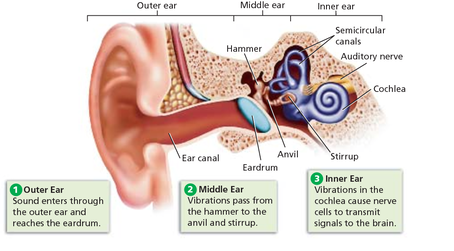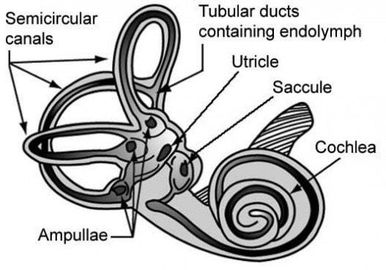BPPV is thought to occur when a small crystal (otoconia) or clump of cellular debris (the body’s own tissues) ends up in a part of our semicircular canals where it does not belong. The otoconia are typically stored in small organs called the utricle/saccule that reside in our inner ear. These organs attach to the ends of our semicircular canals and it is possible for small objects to pass between these areas. The crystals that normally reside inside our ear organs are used by our body to send information about gravity or the movement of our body through space in very specific directions to our brain. They are denser and heavier than the surrounding tissues which allows them to tell the brain what is changing between the relationship of our body and the environment. The current hypothesis is that these crystals can sometimes be dislodged and inappropriately move into the semicircular canals. There is some evidence to suggest that a clump of cells from our own body can sometimes form an object big enough and dense enough to create the same effect.
In some cases, BPPV will resolve spontaneously. The body has the capacity to reabsorb the otoconia or the clump of cells and things will return to normal once the crystal is gone. On the other hand, sometimes people will experience episodic or constant symptoms that can last for months or years. Even after successful treatment there is the chance that the condition will reoccur, but this can typically be resolved with the appropriate treatment.
Treatment for BPPV typically consists of the following:
Canalith repositioning maneuvers - Special positions and movements that a trained therapist can guide a patient through in an effort to relocate or dislodge a misplaced crystal or clump of cellular debris.
Exercise instruction in self-treatment and management strategies - Including self-applied movements for BPPV, balance and gait exercises, or stretching and strengthening exercises for the neck and jaw.
Education regarding the condition, the treatment, and further strategies for returning to regular activity.
Biomechanical treatment of the neck and/or jaw as required - Including hands-on therapy for the joints and muscle tissues.
The first interaction with a therapist will include a detailed assessment. It is important to understand the cause of the disorder as different kinds of treatment and therapy are not indicated for all types of dizziness. The therapist will perform a mechanical examination that can include the neck and jaw, as well as a specialized assessment of the nervous system, walking patterns, balance, and positional tests for the dizziness/vertigo. If BPPV is the diagnosis, the first treatment can often be provided during the initial assessment. Depending on the person's personal situation, exercises can sometimes be prescribed for home use to assist with recovery in between sessions with the therapist. However, as dizziness and compromised balance can be a risk factor for falls and injury, not everyone is a candidate for home exercise programming at first.
- Trent, PT
References
· Clinical Practice Guideline: Benign Paroxysmal Positional Vertigo (Update). Bhattacharyaa, N., et al. Otolaryngology - Head and Neck Surgery. 2017. Vol. 156(3s) S1-S47.
· Treatment of benign paroxysmal positional vertigo. A clinical Review. Perez-Vazquez, P., Franco-Gutierrez, V. Journal of Otology. 2017. Vol. 12 165-173.
· Vestibular rehabilitation in benign paroxysmal positional vertigo: Reality of fiction? Bressi, F. et al. International Journal of Immunopathology and Pharmacology. 2017. Vol. 30(2) 113-122.



 RSS Feed
RSS Feed